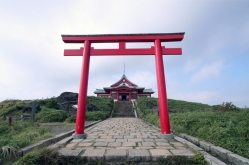H4 駒ヶ岳(こまがたけ)
~溶岩流の地形が明瞭に残る後期中央火口丘の火山~
Mt. Komagatake
ジオサイト解説
駒ヶ岳の山頂はカヤト(※1)となっていて、四方の風景が観察できる場所です。外輪山の森で囲まれた環境は、星空の観察場所としても適しています。また、ハコネコメツツジなどの風衝岩角地の植物群落も見られます。山体は緑に覆われていますが、地形をよく観察すると溶岩流が何枚も見え、この山が度重なる噴火によって、徐々にできてきたことがわかります。
後期中央火口丘(※2)のひとつで、山頂付近には「馬降石」や「馬乗石」などの降臨伝説に基づく 祭祀遺跡 が点在しており、神山と共に古くから信仰を集めていた霊地であったことがうかがえます。
※1 カヤト:山の中で萱(かや)が広がっている開けた場所のこと。
※2 後期中央火口丘:カルデラの中にできた比較的小さな火山体を中央火口丘という。箱根火山では前期、後期2つの活動期がある。
At the base of the Komagatake, one of the central cones(※2), you can see plants such as Rhododendron tsusiophyllum that thrives in windy rocky areas.
The base of Komagatake is covered with greenery, but several lava flows that form the mountain can be recognized if you study the morphology.
At the top of the mountain are remains of ancient worship sites, such as “the Bakoseki” rock, where god is said to have descended to earth.
※2central cones:A compartively small volcanic body formed in a crator.
用語解説

箱根神社の元宮
奈良時代、この里宮として萬巻上人によって開かれたのが箱根神社です。現在、駒ヶ岳山頂には箱根神社の元宮が祀られ、神山を拝する拝殿としての役割を果たしています。
(提供:箱根町観光協会)
